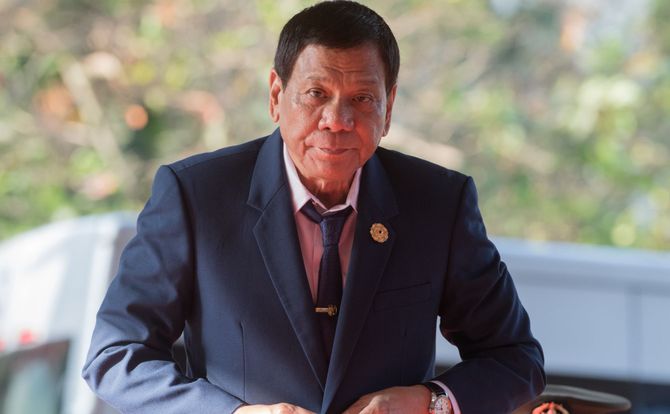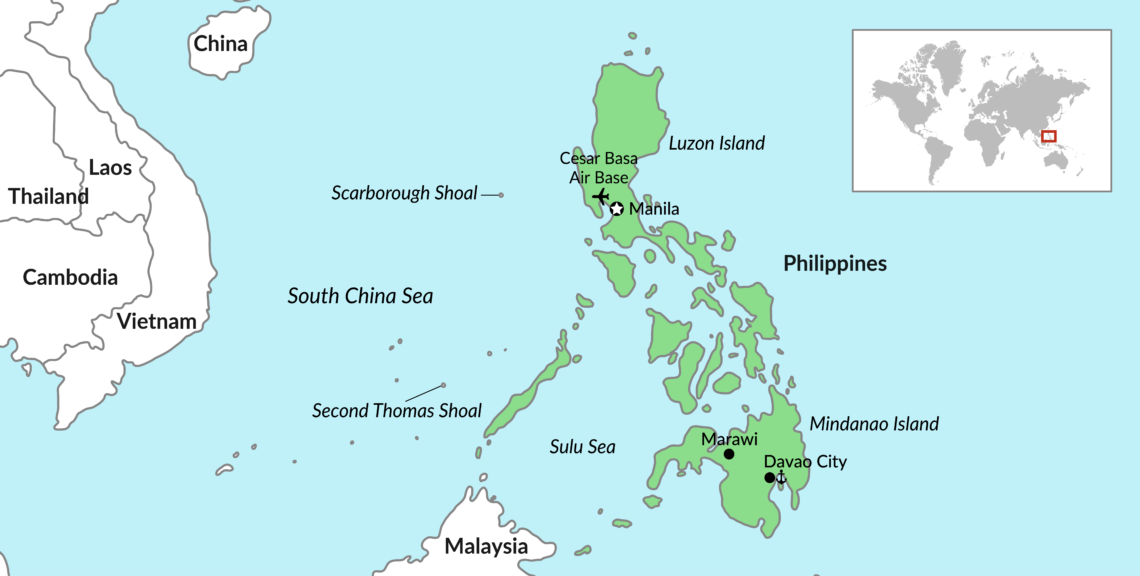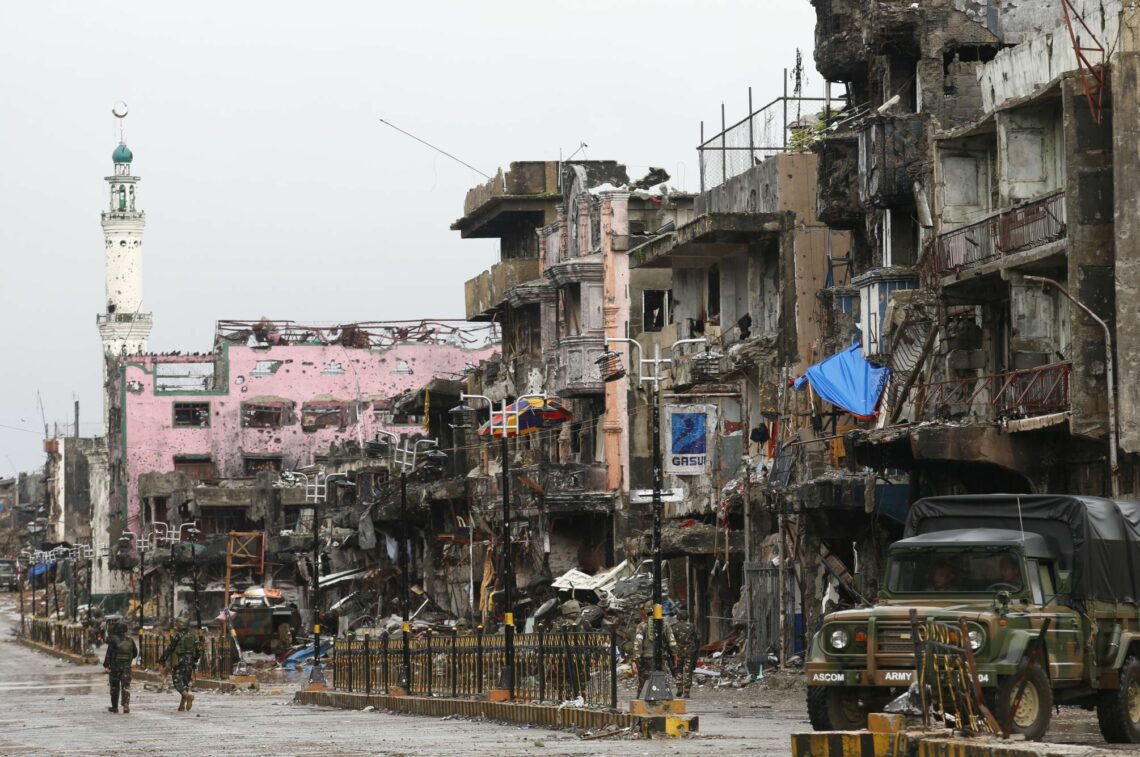Duterte’s impact at the two-year mark
When President Duterte came to power in the Philippines, his plan to reorient the country’s geopolitics toward Beijing was a shock. Although Manila now takes a more neutral line, the U.S. still plays a crucial role in its security. The public is also wary of China, whose moves could cause an uproar and force Mr. Duterte to realign with the U.S.

In a nutshell
- President Duterte has partially realigned the Philippines’ geopolitics
- Filipinos are still very wary of China, despite its promises of investment
- The U.S. remains crucial to the Philippines’ security
In 2016, Philippine President Rodrigo Duterte came to office with a jarring vision for his country’s geopolitical orientation: He would distance Manila from Washington and align it with Beijing. While this plan was never realistic – true realignment would be a complex undertaking beyond the power of one president – Mr. Duterte has succeeded in repositioning the Philippines closer to neutral in the region’s great power dynamics. At the same time, however, the U.S. has kept a strong pull on the Philippines in ways President Duterte cannot ignore.
Where the Philippines goes from here depends on several key variables.
The South China Sea
The central bet Mr. Duterte made was to set aside the South China Sea territorial dispute so that he could make the most of Chinese economic ties while reducing the Philippines’ reliance on the U.S. for security.
President Duterte has made three visits to China. The first, in 2016 – during which he publicly announced his “separation from the United States” – garnered $24 billion in loan and investment pledges from the Chinese. In 2017, he attended China’s high-profile Belt and Road Forum. Then, in April 2018, he made another visit, this time to the Boao economic forum, from which he brought home another $9.5 billion in investment pledges.
For President Duterte’s formula to succeed, the Chinese must moderate their behavior in the South China Sea.
China’s promises, however, will take time to materialize – if they ever do. There is some doubt on this score in the Philippines. Through 2017, Japanese companies invested 13 times more than Chinese firms in the country, and the gap grew in the first quarter of 2018. U.S. investments in the Philippines were three times larger than China’s over the same period. Even Taiwan invests more.
When it comes to trade, China is the Philippines’ biggest partner, but it exports far more to the Philippines than it imports. Japan and the U.S. are bigger export markets for Filipino goods.
Beyond investment pledges, China has responded in other positive ways to President Duterte’s overtures. In June and October of 2017, it made high-profile deliveries of arms – mostly rifles to the Philippine police – something the U.S. had refused to do out of concern for victims of Mr. Duterte’s drug war. The Chinese navy also made its first port call to the Philippines in seven years. The flotilla, consisting of three ships, including a guided missile destroyer, called on Davao, where President Duterte boarded to greet them. This is an honor he has not yet granted to any of the many American ships to have visited the Philippines.
For President Duterte’s China formula to succeed, the Chinese must not only deliver on the promises of economic engagement, they must moderate their behavior toward the Philippines in the South China Sea. Without this, despite economic benefits, Mr. Duterte will face a domestic backlash that could cause him major political problems. Safeguarding the nation’s sovereignty is important to the Filipino electorate. Indeed, allegations that it was being compromised in the South China Sea contributed to the serious troubles of Gloria Macapagal- Arroyo’s presidency (2001-2010).
China’s actions there show a mixed picture. On one hand, it has permitted Filipino fishermen access to Scarborough Shoal, in accordance – although not explicitly in compliance – with the Permanent Court of Arbitration’s 2016 ruling. On the other hand, the Chinese remain in sole control of the shoal and its coast guard regulates access, allegedly occasionally confiscating the catch of Filipino fishing boats. In May of this year, the Philippine Navy was harassed by a Chinese helicopter as it conducted a routine replenishment mission at Second Thomas Shoal. More importantly, the Chinese installed missiles on three of the seven islands it has reclaimed in the South China Sea.
Facts & figures
The Philippines

Developments like these attract attention and aggravate anti-Chinese feeling. They have led to a growing critique of President Duterte’s China policy. This, in turn, led the administration to publicly lay down “red lines” on the South China Sea to include reclamation or building at Scarborough Shoal, aggression against Filipino troops at Second Thomas Shoal or a move to unilaterally drill for resources in disputed areas. The threat “to go to war” over any of these red lines is not credible – especially outside of rigorous coordination with the U.S. Yet, they are very clear markers for evaluating Chinese behavior from which it would be difficult to retreat.
War on Terror
The most significant security development in the Philippines over the last two years was its battle against Islamist militants for control of the city of Marawi on the southern island of Mindanao. The 2017 conflict – which ended with Philippine national forces in full control – claimed the lives of 165 Filipino troops and left the city thoroughly destroyed. The fighting was a stark reminder of the Philippines’ vulnerability to separatist violence – and just how bloody it can become.
It was also a reminder of how important the U.S.-Philippines security relationship is. In 2015, the U.S. ended a 13-year special operations train-and-assist mission in Mindanao. In response to the fighting in Marawi, the U.S. quietly ramped up a replacement: Operation Pacific Eagle–Philippines. The new 200- to 300-person mission helped provide intelligence, surveillance, logistics and advisors in the field. Deployed in the midst of the conflict, its objectives are now much broader. The operation is intended to “halt and reverse the degradation of an already unstable area and prevent the southern Philippines from becoming a safe haven for terrorists.” It has no stated end date. This represents a major change of course for President Duterte, who only a year earlier had demanded the departure of what was then only a handful of U.S. Special Forces.
The U.S. donated counterterrorism equipment early in the conflict, including carbines, pistols, grenade launchers and machine guns, as well as Cessna aircraft for surveillance. The Chinese contributed to the effort as well. There were the two arms shipments referenced above, which arrived during the fighting. President Duterte embellished the importance of these shipments by making the dubious claim that one of the Chinese sniper rifles was used to kill the terrorist ringleader in Marawi. In addition, the Chinese made modest pledges of humanitarian assistance and donated 47 pieces of heavy construction equipment to help with the rebuilding. Now, China is front and center in the $1 billion competition to reconstruct Marawi. In fact, a Chinese consortium won the first round of the bidding process, only to be disqualified later.

Reconstruction will involve a new set of political challenges. There are initial signs of discontent among the local population about the Chinese development approach. The Chinese, however, with President Duterte’s assistance, have made the most of their contributions, despite distrust from the Filipino public and awareness among the ruling class that the U.S. was a far more consequential contributor to the victory in Marawi.
U.S. adjustments and staying power
Despite President Duterte’s anti-American, pro-Chinese rhetoric, the U.S.-Philippines relationship has continued without major change.
In November 2017, Mr. Duterte reaffirmed Philippine support for a 2014 agreement to allow the U.S. to rotate its military through five Philippine military bases (initially), as well as to preposition equipment for humanitarian and disaster-relief missions. Called the Enhanced Defense Cooperation Agreement (EDCA), it also provides for the U.S. to upgrade Philippine base installations. And though President Duterte continues to publicly express misgivings about this specific aspect of the relationship, construction began at one of the facilities – Cesar Basa Air Base on the northern island of Luzon – in April 2018.
U.S.-Philippines joint military exercises continue as well, albeit with some adjustments to placate Manila’s new concerns regarding China. For instance, joint naval patrols in the South China Sea begun under the Obama administration were halted. But new ones, with no China-related overtones, were conducted in the Sulu Sea. Cooperation Afloat Readiness and Training (CARAT) naval exercises were canceled, but a new “Maritime Training Activity” called Sama Sama was inaugurated. A new exercise focused on counterterrorism and humanitarian assistance, KAMANDAG, took the place of the PHILBEX amphibious landing exercises.
The alliance’s biggest annual exercise, Balikatan, took place on schedule in each of the last two years. After scaling back the size and mission in 2017, the two sides committed a total of 8,000 troops and restored live fire and amphibious exercises in 2018. These activities are among 261 interactions the U.S. will have with the Philippines armed forces in 2018. There have also been frequent U.S. Navy port calls, including visits by three different American aircraft carriers.
At the political level, there has been an improvement in U.S.-Philippine relations.
At the political level, there has been an improvement in bilateral relations. President Trump and the current U.S. ambassador in Manila, Sung Kim, have gotten along much better with President Duterte than their predecessors. Whether Mr. Duterte used the change of administration in Washington as an excuse to tone down some of his extreme rhetoric, or whether it is because the U.S. government has been less publicly critical of him lately, there seems to be a new rapport at the head-of-state level. This has given President Duterte room to moderate his positions regarding the alliance.
The wild card in the relationship remains President Duterte’s war on drugs. The controversial policy has resulted in the deaths of between 4,000 (according to the Philippine police) and 12,000 (according to the human rights community) people. The U.S. Congress has reacted by legislating restrictions on counternarcotics assistance and otherwise pressuring the Trump administration to limit contact with the Philippine police. Thus far, its concern has largely exempted the Philippine armed forces.
Scenarios
The most likely scenario for the Philippines is what we could call “pro-American neutrality.” Under this scenario, both the U.S. and China play their cards right. The Chinese avoid provoking President Duterte into rethinking his gamble or providing fodder to his domestic opponents on matters of sovereignty. Mr. Duterte wins his bet to draw in China economically, but security needs – and pressure from the Philippine defense establishment – will require a strong relationship with the U.S.
In this scenario, the Trump administration continues to refrain from high-profile public criticism of President Duterte’s drug war. However, this approach could be undermined by a newly activist U.S. Congress. The Democrats regaining control of the House of Representatives or the Senate could precipitate this, as could charges of major abuses by the Philippine military. A possible change in the U.S. ambassador to the Philippines is another factor. Any transition will need to be managed very carefully, since Ambassador Kim has played a key stabilizing role.
If China misplays its cards and crosses any of the Philippines’ red lines, President Duterte will be forced to backtrack and cool his pro-Beijing rhetoric. An armed response from the Philippines is unlikely, not least because Manila lacks the military wherewithal. The Philippine Armed Forces are incapable of major operations without U.S. backing, which is doubtful unless the country were attacked and invoked the bilateral security treaty. Even in this case, the circumstances would shape the American reaction.
Pressure will also build on President Duterte’s China policy, albeit more slowly, if Beijing does not deliver on its investment promises. Mr. Duterte’s personal antipathy to the U.S. will make it harder to modulate his rhetoric to more traditional, pro-American positions. But military-to-military relations would quickly improve and reorient their missions to the previous focus on countering China. The government would also step up its engagement with Russia, Japan and Australia.
Either of these Chinese misplays would destabilize President Duterte’s government. Today, he remains very popular in the Philippines. The South China Sea issue is not a central consideration for the electorate, but it is something that Filipinos care about, especially to the extent that it affects national sovereignty. Elite opinion in the Philippines has a way of filtering down to the larger public, then changing the whole thrust of domestic politics. Suddenly, a problem that involves disputed maritime claims could become a much bigger, multifaceted political crisis for President Duterte.








